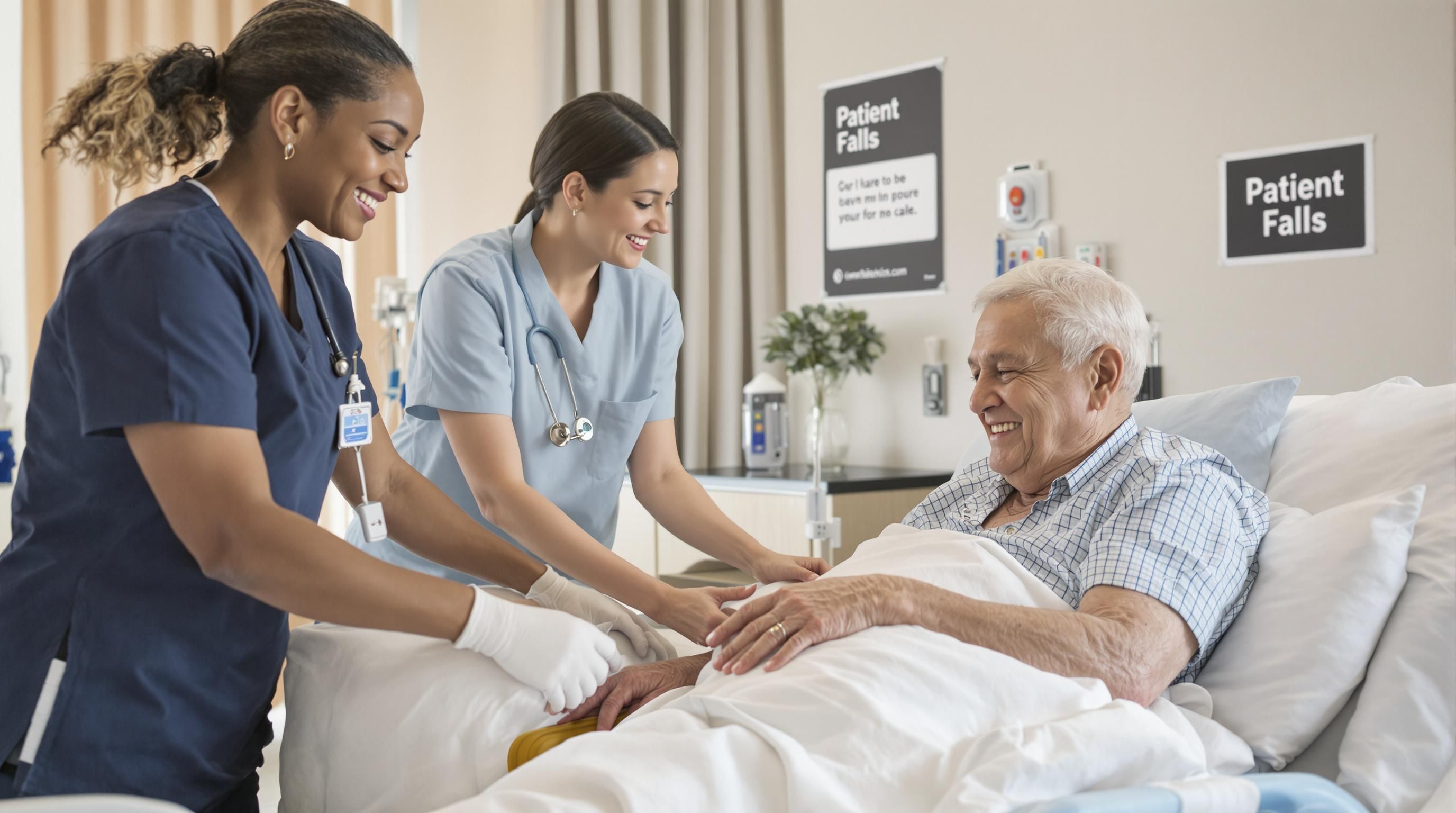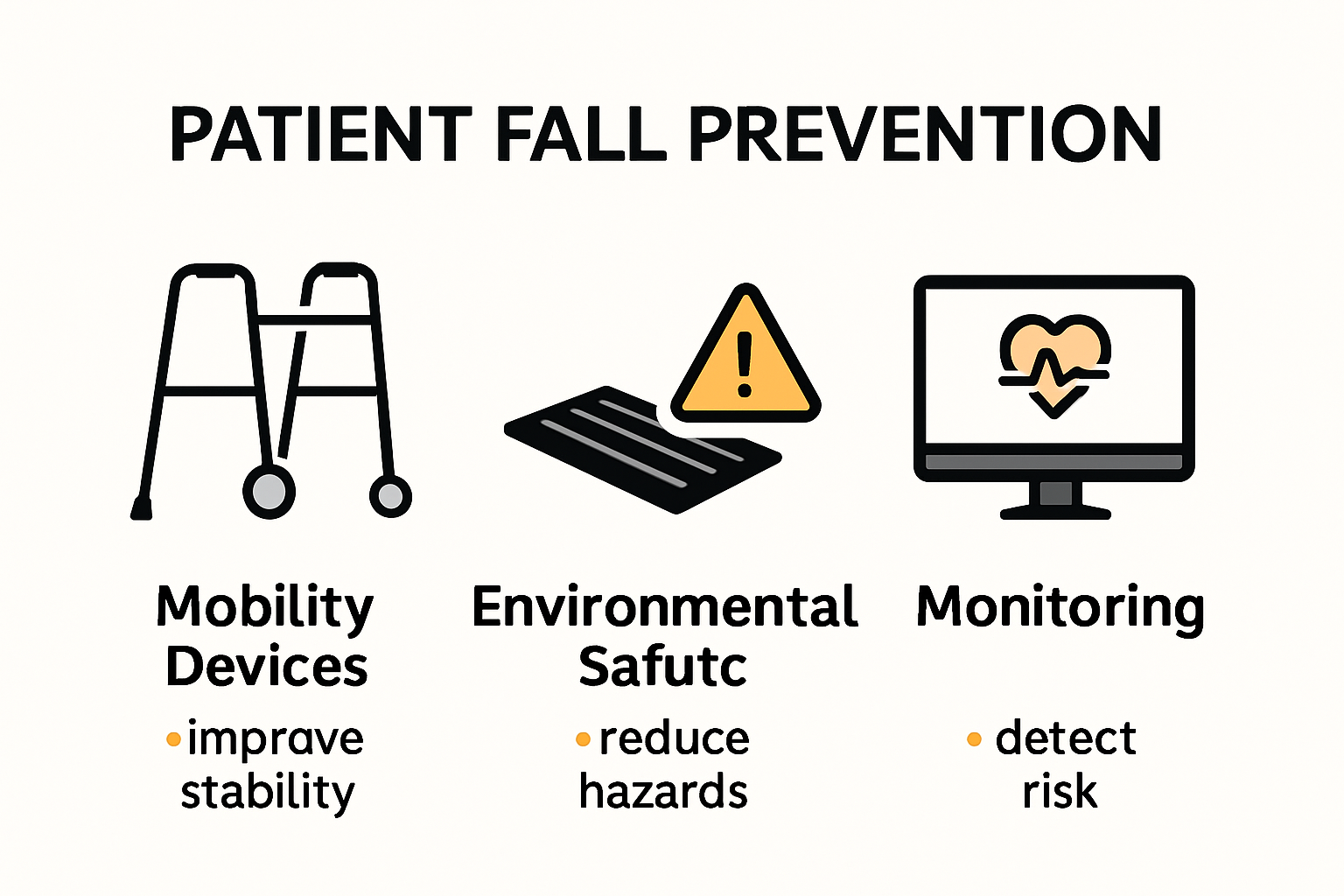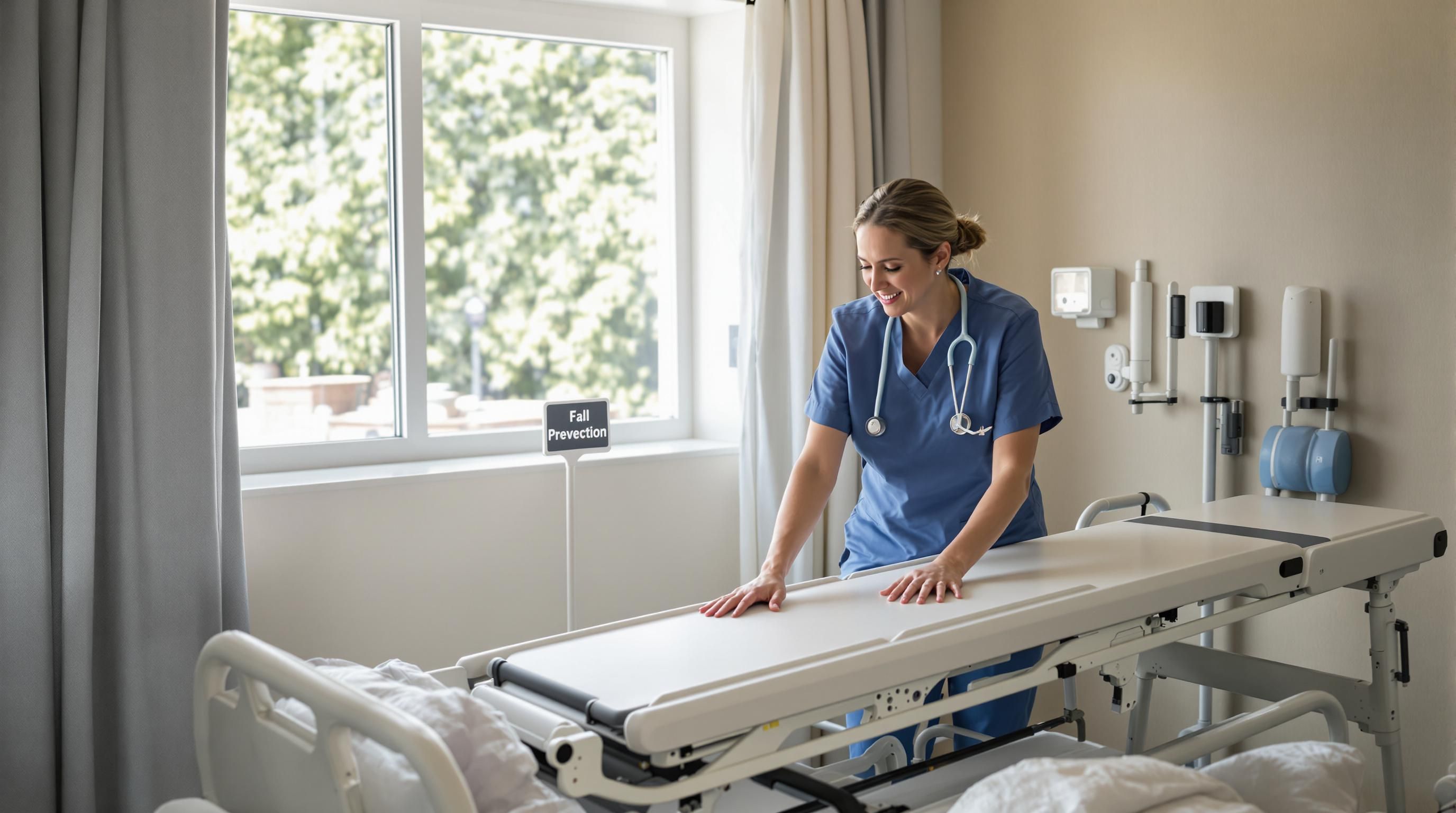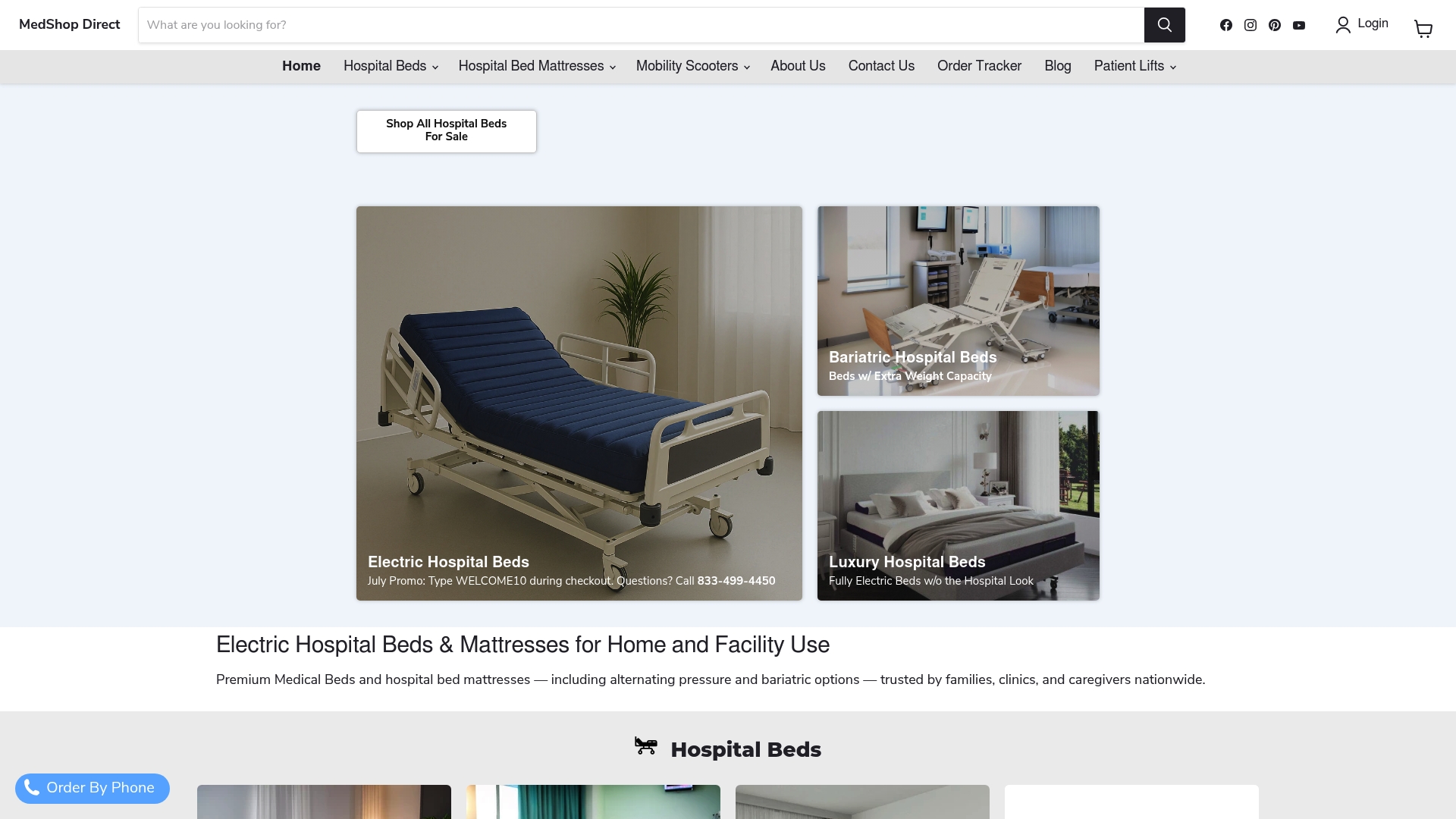

Patient falls are one of the top challenges in hospitals with up to one million patients falling each year in U.S. hospitals alone. Most people expect new technology to solve this, or think better medical gear is all it takes. But the real secret is in the details—tiny shifts in routine, simple changes in layout, and smart staff training can cut fall rates dramatically. Surprised? You’ll want to see how these unexpected tactics make all the difference for patient safety in 2025.
| Takeaway | Explanation |
|---|---|
| Understand intrinsic fall risk factors. | Recognize that patient age, cognitive impairments, and certain medications significantly elevate fall risks. |
| Implement environmental safety measures. | Use proper lighting, remove clutter, and maintain clear pathways to prevent falls in care environments. |
| Utilize mobility and assistive devices. | Equip patients with walkers, gait belts, and transfer boards to enhance safety and mobility. |
| Conduct comprehensive risk assessments regularly. | Regularly evaluate patient status and adjust fall prevention strategies based on individual needs and conditions. |
| Train staff in safe transfer techniques. | Educate caregivers on effective patient transfer methods to reduce fall risks during mobility assistance. |
Patient falls represent a serious healthcare challenge that impacts patient safety and quality of care. Understanding the underlying causes is crucial for developing effective prevention strategies. Falls can occur due to complex interactions between patient characteristics, environmental factors, and healthcare system limitations.
Individual patient characteristics play a significant role in fall vulnerability. Research from the U.S. National Library of Medicine reveals multiple intrinsic factors that increase fall risk. Age is a primary contributor, with older patients experiencing decreased muscle strength, balance problems, and reduced mobility. Chronic conditions such as Parkinson’s disease, arthritis, and neurological disorders can further compromise a patient’s physical stability.
Cognitive impairments significantly elevate fall risks. Patients with dementia, confusion, or altered mental states may not recognize environmental hazards or understand movement limitations. Medication side effects also create substantial fall risks. Certain drugs like sedatives, antidepressants, and blood pressure medications can cause dizziness, reduced coordination, and sudden blood pressure changes that compromise patient stability.
The Agency for Healthcare Research and Quality highlights critical environmental factors contributing to patient falls. Poor lighting, cluttered spaces, inadequate mobility support, and slippery surfaces create substantial risks. Hospital rooms often contain multiple obstacles like IV stands, medical equipment, and complex bed mechanisms that can challenge patient movement.
Systemic issues within healthcare settings also contribute to fall risks. Insufficient staff communication, inadequate patient assessment protocols, and limited patient monitoring can create dangerous scenarios. Staff training, comprehensive risk assessments, and implementing standardized fall prevention protocols are essential strategies for mitigating these risks.
Effective fall prevention requires a holistic approach that addresses multiple risk dimensions. Healthcare providers must conduct thorough individual assessments considering physical capabilities, cognitive status, medication impacts, and environmental conditions. Personalized intervention strategies that combine assistive technologies, environmental modifications, and patient education can significantly reduce fall incidents.
Understanding these multifaceted causes empowers healthcare professionals to develop targeted, proactive fall prevention strategies. By recognizing the complex interplay between patient characteristics and environmental factors, medical teams can create safer, more supportive care environments that protect patient well-being and reduce potential injury risks.
Preventing patient falls requires strategic selection of medical supplies that support mobility, enhance safety, and provide critical support for patients with varying physical capabilities. The Agency for Healthcare Research and Quality emphasizes the importance of targeted medical equipment in comprehensive fall prevention strategies.
Mobility devices play a crucial role in patient fall prevention. Walkers, canes, and rollators provide essential stability for patients with balance challenges or muscle weakness. Adjustable walkers with wide bases offer increased support and confidence during movement. Forearm crutches can help patients with partial weight-bearing needs maintain balance while navigating different environments.
Transfer aids are equally important for patient safety. Gait belts allow caregivers to provide physical support during patient transfers, reducing the risk of sudden falls. Specialized transfer boards help patients move between surfaces with minimal physical strain, minimizing fall risks associated with complex movement patterns.
Here is a summary table of essential fall prevention equipment mentioned in this section. This table groups devices by their primary function to help staff quickly identify the best tools for different needs.
| Type of Equipment | Examples | Primary Purpose |
|---|---|---|
| Mobility Devices | Walkers, Canes, Rollators, Forearm Crutches | Provide stability for walking and movement |
| Transfer Aids | Gait Belts, Transfer Boards | Assist with safe patient transfers between surfaces |
| Environmental Safety Equipment | Bed Exit Alarms, Non-slip Mats, Floor Markings | Alert staff and reduce risks in patient environments |
| Bathroom Safety Equipment | Grab Bars, Raised Toilet Seats, Shower Chairs | Support safe bathroom use and reduce risk of bathroom falls |
| Specialized Support Technologies | Wearable Sensors, Adjustable Hospital Beds | Monitor patient activity, support movement, and alert staff |
Environmental safety equipment is critical in fall prevention strategies. Bed exit alarms provide immediate notification when patients attempt to leave their beds unassisted, allowing caregivers to intervene quickly. Non-slip mats and floor markings create visual and tactile guides that help patients navigate spaces safely.
Bathroom safety equipment is particularly important. Grab bars near toilets and showers provide critical support points for patients with limited mobility. Raised toilet seats reduce the physical effort required for sitting and standing, minimizing fall risks during bathroom activities. Shower chairs and transfer benches offer stable seating options for patients who struggle with standing for extended periods.
Advanced medical technologies now offer sophisticated fall prevention solutions. Wearable sensors can track patient movement patterns and detect potential fall risks in real time. These devices provide continuous monitoring, alerting healthcare staff to sudden changes in patient positioning or unexpected movements.
Specialized hospital beds with adjustable heights and side rails offer additional protection. Low-profile beds allow easier patient entry and exit, while integrated side rails prevent unintended rolling or falling. Some advanced beds include pressure-sensitive monitoring systems that can detect when a patient is attempting to move without assistance.
Selecting the right medical supplies requires a personalized approach. Healthcare providers must assess individual patient needs, considering factors like physical condition, cognitive status, and specific mobility challenges. By implementing a comprehensive range of supportive equipment, medical teams can create safer environments that significantly reduce fall risks and support patient independence.

Safe patient transfers and bed mobility are critical components of fall prevention, requiring careful planning, specialized techniques, and comprehensive staff training. Research published in the International Journal of Environmental Research and Public Health underscores the complexity of managing patient movement while minimizing fall risks.
Successful patient transfers begin with thorough individual assessment and personalized approach. Healthcare professionals must evaluate each patient’s physical capabilities, strength, balance, and cognitive status before implementing transfer strategies. This individualized evaluation helps determine the most appropriate transfer method and necessary assistive devices.
Prior to any transfer, patients should be instructed to move slowly and deliberately. Communication plays a crucial role in coordinating movements between the patient and caregiver. Clear, step-by-step verbal guidance helps patients understand the transfer process and feel more secure during movement. Ensuring the patient feels confident and supported reduces anxiety and minimizes unexpected movements that could lead to falls.
The National Institute on Aging recommends specific strategies for safe bed mobility. Before standing, patients should practice sitting on the edge of the bed, allowing time for blood pressure stabilization and reducing dizziness risk. Caregivers should encourage patients to pause momentarily after changing positions, helping prevent sudden balance disruptions.
Specialized transfer techniques like the rock and roll method can assist patients with limited mobility. This approach involves guiding the patient to roll onto their side, use their arms to push into a sitting position, and then carefully stand with support. Gait belts provide additional security during these movements, allowing caregivers to offer physical guidance and prevent unexpected falls.
Below is a detailed process table summarizing the recommended steps for safe bed mobility and transfers as described in the section.
| Step | Description | Purpose/Reason |
|---|---|---|
| Assess patient capabilities | Evaluate strength, balance, cognition, and mobility | Choose safest transfer method |
| Explain transfer process | Communicate step-by-step instructions to patient | Increase confidence, reduce anxiety |
| Move slowly and deliberately | Patient instructed to move carefully, not rush | Prevent dizziness, ensure controlled movement |
| Sit at bed edge | Patient sits, allows time for blood pressure stabilization | Reduce dizziness and risk of sudden falls |
| Pause before standing | Encourage patient to pause after position changes | Prevent sudden balance loss |
| Use transfer aids (if needed) | Employ gait belts, transfer boards as appropriate | Provide support, reduce physical strain |
| Support from caregiver | Caregiver provides hands-on physical and verbal guidance | Coordinate movement, offer security |
Effective fall prevention requires ongoing staff education and environmental modifications. Healthcare providers must receive comprehensive training in proper transfer techniques, understanding body mechanics, and recognizing individual patient limitations. Simulation-based training can help caregivers practice safe transfer methods in controlled settings.
Environmental preparation is equally important. Clear pathways, strategically placed furniture, adequate lighting, and readily available assistive devices create safer mobility spaces. Non-slip flooring and clearly marked walking areas further reduce fall risks during patient transfers.
Technology can also enhance transfer safety. Mechanical lift systems and transfer boards provide additional support for patients with significant mobility challenges. These tools reduce physical strain on both patients and caregivers while ensuring more controlled, predictable movements.
Ultimately, safe transfers and bed mobility demand a holistic approach. By combining individualized assessment, specialized techniques, staff training, and supportive technologies, healthcare providers can significantly minimize fall risks and promote patient independence and confidence during movement.
Ensuring patient safety requires a comprehensive approach that goes beyond individual interventions. The Agency for Healthcare Research and Quality emphasizes the critical role of staff and caregivers in implementing effective fall prevention strategies.
Universal fall precautions form the foundation of patient safety across all healthcare settings. These standardized protocols apply to every patient, regardless of their individual risk profile. Staff must consistently implement fundamental safety measures such as maintaining clear walkways, ensuring adequate room lighting, and promptly addressing potential environmental hazards.
Communication becomes a vital tool in fall prevention. Healthcare providers should establish clear communication channels that allow immediate reporting of potential risks. This includes creating comprehensive handoff procedures where patient mobility challenges and specific fall risks are explicitly discussed during shift changes. Detailed documentation and consistent information sharing help create a comprehensive safety net for patients.
Research published in BMC Geriatrics highlights the importance of patient education in fall prevention. Caregivers must develop targeted educational approaches that empower patients to understand and participate in their own safety. This involves creating clear, accessible materials that explain fall risks, demonstrate safe movement techniques, and provide practical guidance.
Interactive education strategies can include direct face-to-face counseling, demonstrative training sessions, and providing take-home educational resources. Visual aids, instructional videos, and personalized safety plans can help patients better comprehend their individual fall risks and the strategies they can employ to prevent accidents.
The Fall TIPS Program emphasizes the importance of individualized fall risk assessments. Caregivers must conduct thorough evaluations that consider multiple factors including patient mobility, medication effects, cognitive status, and environmental conditions. These assessments should be dynamic, with regular reassessments to capture changes in patient condition.
Engaging patients and their families in fall prevention becomes crucial. This collaborative approach involves explaining risk factors, demonstrating safe techniques, and creating personalized prevention strategies. Families can be trained to recognize potential fall risks and support safe patient mobility.
Technology and continuous staff training complement these strategies. Regular simulation-based training helps healthcare providers refine their skills in patient transfer, risk identification, and emergency response. Technological tools like patient monitoring systems and real-time alert mechanisms provide additional layers of safety.
Ultimately, successful fall prevention requires a holistic, patient-centered approach. By combining universal protocols, targeted education, comprehensive risk assessment, and ongoing staff training, healthcare providers can create safer environments that protect patient well-being and promote independence. 
Patient falls in hospitals are primarily caused by a combination of intrinsic factors such as patient age, cognitive impairments, and medication side effects, along with environmental hazards like poor lighting and cluttered spaces.
Healthcare staff can prevent patient falls by implementing universal fall prevention protocols, conducting comprehensive risk assessments, and ensuring ongoing training in safe transfer techniques and effective communication.
Essential medical supplies for fall prevention include mobility devices (walkers, canes), safety equipment (bed exit alarms, non-slip mats), and specialized monitoring technologies (wearable sensors, adjustable beds) to support patient mobility and safety.
Patient education is critical in preventing falls as it empowers patients to understand their risks and engage in their safety. Caregivers should provide clear instructions and resources to help patients adopt safe movement techniques.
If the statistics from our article have you worried about patient falls in your medical facility, you are not alone. The anxiety that comes from not knowing if patients are truly safe at night or during transfers is real, especially when you consider the evolving risks discussed in our fall prevention guide. Many caregivers and facility managers feel it every day. You have just learned how vital mobility aids, bed safety features and advanced monitoring technology are in tackling these risks. Why worry about preventable accidents when reliable solutions are within your reach?

Now is the time to transform patient safety. Visit MedShop Direct to explore our trusted range of hospital beds, alternating pressure mattresses, and patient lifts. Each product is designed to support the very strategies outlined in our article, helping staff and families achieve safer, more confident care. Discover our customer reviews and product details today, and take the next step toward fall prevention and peace of mind. Your patients and their loved ones deserve it—see what solutions fit your needs now at MedShop Direct.
placeholder